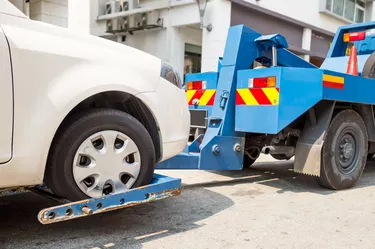
Repossessing a vehicle that's in default can be tricky, especially if the car owner knows repossession is a risk. However, a smart repo man knows some simple tips and tricks that can help him locate the vehicle and return it to the lender without causing a fuss or violating local laws.
Finding the Vehicle
Video of the Day
The first step to repossessing a car is determining where it is. The lender will have the last known billing address, but vehicle service records may provide more recent information, particularly if the car was brought in for maintenance recently. Call the dealership where the car was purchased and ask if the vehicle is being serviced there; you may get a different address than the one the lender provided.
Video of the Day
Skip tracing services take that a step further and involve using all means at your disposal to track down a wayward vehicle and its owner, whether it's scouring credit reports and utility bills or using social media, such as going online to check the borrower's Facebook, Twitter or other social media accounts for clues. You might visit the last known address to see if the neighbors know where the car owner went. If you're contacting anyone besides the debtor, though, you're limited by the Fair Debt Collection Practices Act to asking for information about the debtor's address, phone number and workplace.
This effort might not be cost-effective for an older, low-value car, but for a newer car with a sizable loan balance, it can be time well spent. A good GPS is essential for finding your way to the address. Always confirm that the car is the one you're looking for, using the vehicle identification number and the license plate, before starting the physical repossession.
Tip
If the car's not in the garage or the driveway, look elsewhere in the neighborhood. Many debtors who fear repossession park the car several blocks from home, believing that that makes it a bit harder for creditors to find while still being close enough to access easily.
Follow State Laws
State laws regulate much of the repossession process. In many states, you can repossess the car as soon as the payment is in default, a date that depends on the owner's loan or lease agreement. Federal law prohibits any breach of the peace in a repossession, but what that term actually means varies by location. Whether or not you can open a gate or a garage to get to the car without permission, for example, depends on state law. Should you do either in a state that considers that a breach of the peace, you could have to pay a penalty or compensate the owner for any damage caused. Some states require you to alert the police department that you plan to repossess the car or inform police immediately after you do so.
Tools and Techniques
Vehicle repossession can occur several ways. If you have a spare key or a replacement key, that makes things easy: Just drive the car to the desired location. Otherwise, a tow truck is commonly used to hook up the vehicle and get it to your lot. If you find the car in a hard-to-reach spot -- parallel parked between vehicles without space for a tow truck to maneuver -- jacks and hoists can be used to slide the vehicle out to an accessible spot.
Other tools that can help with a repossession are decidedly low-tech. Spraying the car's wheels and tires with a soap and water solution, and giving the same treatment to the flatbed of a tow truck, can add some lubricant that decreases the noise of tires moving over rocks or gravel that otherwise might alert the owner to your presence. Don't leave a mess behind that could cause the owner to slip and fall if he comes out to challenge you; that could be considered a breach of the peace.
Timing and Storage
Your safest bet is to repossess the car when the vehicle owner is asleep or at work. While some repo men pride themselves on their ability to talk a car owner out of the vehicle during a repossession, any confrontation at a debtor's house that turns physical likely puts you in an uncomfortable legal position. Once the car is in your possession, keep it in a secured area, ideally one with several locks and security cameras. This prevents the person whose vehicle was repossessed from using his key to slip back into the car and drive it off your property.